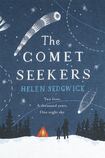
‘Things shifted while he wasn’t looking at the ground and now the world is different; everything is beautiful, and wild, and precarious, because now he knows how the sky can change.”
While watching a comet light up the darkness of rural Ireland a young boy experiences his first kiss. It is "the sweet, soft kiss of children, of cousins and best friends".
Explosions are going off from the beginning of Helen Sedgwick's debut novel, The Comet Seekers, but the author is firmly in charge of the volume.
Her laconic tone and measured prose belie the novel’s dramatic content, which in lesser hands could be salacious. In a book that covers centuries – through the clever narrative device of using comets to see into characters’ lives – and two main stories, the one with the Irish backdrop is the most engaging.
Nine-year-old Róisín is an aspiring astronomer from rural Ireland, a child whose head is in the clouds. Her seven-year-old cousin Liam, who has recently lost his mother, follows Róisín around the farm on her star-gazing adventures. Their contained world is beautifully related by Sedgwick, gaining the reader’s sympathy from the off. When their love turns sexual as teenagers, there is a complexity to their relationship that will leave many rooting for them.
A second, less compelling and at times repetitive narrative is set in Bayeux, in France, and looks at a family haunted by the ghosts of their ancestors. Severine, a new mother, is the most recent member to be visited, after her beloved grandmother dies. The choice she has to make – to always remain in Bayeux and help her ancestors to navigate their pasts, or to travel the world as she wishes with her son François – causes constant turmoil. While her son encourages her to move on, Severine is beholden to the ghosts: "You are offered a chance to see someone you love again. Is that even a choice?"
The Comet Seekers opens with François and Róisín meeting as adults on an astronomy mission to Antarctica.
Short chapters subsequently loop back over their lives and the lives of their ancestors to see what brought them together. These chapters are headed by various comets, their paths reaching back centuries.
Connections between strangers down through the ages is a central theme. “You go back far enough and you can see that everyone in the world is family,” as François notes when he has a sense of deja vu about red-haired Róisín.
Sedgwick is a highly evocative writer who makes excellent use of nature to showcase her themes. It is not just the comets that are falling everywhere we look, with their spectacular deaths “that split and fracture and split again, and one by one the fragments catch fire in the atmosphere of the planet”. Her characters are in turmoil, too, hurling themselves into situations that they know will hurt – but doing so anyway.
In Róisín she has created an enigmatic and original lead, the kind of girl who wonders, “Why draw a square house with a triangular roof when you can draw the patterns in the stars?”
As her secret life with Liam threatens to fester, Róisín takes off on her astronomy travels, leaving a lonesome and pitiable man behind. His pleas that “the ground is just as important as the sky” bring her back, but the restless adventurer within wins out.
Róisín wants to spend her life “with people who are driven to explore the world, not those who are willing to follow”. It is a moment of quiet revelation that will have consequences.
In this, and in its setting and themes, it recalls the work of Donal Ryan. Danielle McLaughlin is another who comes to mind. Sedgwick shares the Cork writer's ability to mine the atmosphere for sparkly nuggets.
Much of her space talk is metaphorical: “Our sun is on its own, but a lot of stars come in pairs, and orbit each other . . . Sometimes material from one of the stars gets sucked into its partner, so one gets bigger and bigger and one smaller and smaller”.
The author’s eye is also drawn to domestic detail, from the loneliness of a new mother who wonders “how the house could feel so empty when there was so much noise” to “a disused water tank that made her ache with its futility”.
Sedgwick, who has family links to Dublin, was born in Scotland and worked as a research physicist before turning her hand to writing. Her charming debut maps the world’s big questions on an even larger plane.
Calling to mind those famous lines from The Tempest about the insubstantial pageant of life, Róisín sums it up: "But under all that, there is perhaps a part of her that knows we are too small to matter. Nothing happened, that's the thing. The universe carried on, the comets kept coming – it made no difference."
Sarah Gilmartin is an arts journalist















